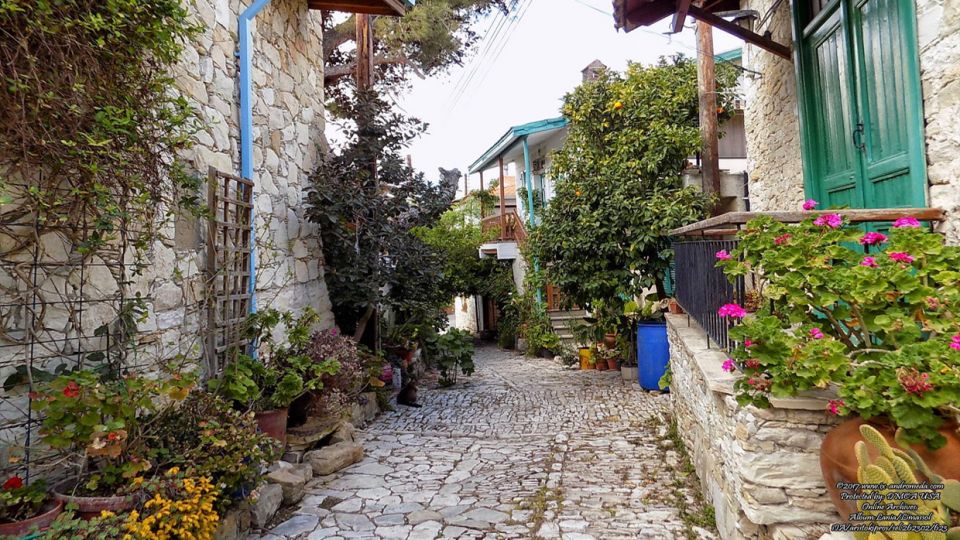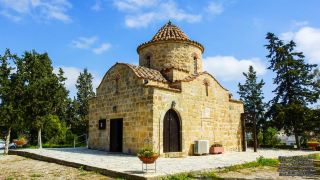Upon travelling from Limassol to Troodos, just before the village of Trimiklini, you will see the village of Lania. It is built northeast of the slope of the valley of the Kourris river, on the food of the hill “Valana”.
It is a small village and only has 300 permanent settlers. From the first moment you enter the village, you will realise that it has a lot to offer. If you walk along the narrow, paved streets, you will begin learning about the huge history they “hide”.
We walked along the village from side to side. Many hours from the time the first click of our photographs passed, and we did not want to leave it. We did not have the time to see houses, streets, museums, squares, churches, parks. At every corner there was a special stop to view the valley of Kourris that spread in front of us.
Each house has high walls, decorated with all sorts of flowers. The yards are clean and they hosted huge wine jars, souvenirs of the village’s thousand year history.
To understand this history, we should “travel” 3500 years back in time. Back to when the Achaeans left Troy and being exiled from their towns and kingdoms, arrived to the welcome beaches of Cyprus.
Many of them went quite deep into the island and after they reached rough and inaccessible areas for the pirates that destroyed the beaches of Cyprus to build their settlements. Along with the Achaeans, their gods came too. God Dionysos, being accompanied by his daughter Lana and the Bacchantes, settled a little further from the mountain peak called “Valana” and at nights he called the Cypriot Naiades and they had fun altogether drinking the famous wine that was produced in the surrounding areas.
In the honour of the god, the residents gave the name of his daughter to their settlement. The industriousness of the settlers, along with the help of the gods, transformed large areas of the Valana hill into vineyards. The village prospered and grew.
1500 years went by and a new religion came upon the island; Christianity. The old religion gave its place quickly to the new one. New Temples dedicated to new Gods were built in Lania. Groups of worshippers of the new Religion arrived to the island and built monasteries, thus creating their own fief. One of them was that of Valana, that developed wine production greatly, resulting to the village becoming the biggest in the whole island in terms of wine production.
One of the grape stomping machines, where the extraction of must was made from grapes, is still there in Lania and its dimensions are impressive. During the first years of Christianity, Agios Epifanios passed by Lania.
A lot later, when Eric was the king of France, a plant illness wiped the vines of Kampania out.
In his effort to find others to replace them, he followed the rumour that was going around the vines in Lania and this is how he reached the village. Being impressed by the quality of the wine, he ordered the production of grafts so that he could take them back to Kampania.
The King, during his whole stay at Lania, encamped under the famous Oak of Lania. It was a huge oak whose branches spread on a great area. This tree was there until a few decades ago and was a destination for all Cypriots. There is no Cypriot who is over forty years old and who does not “know” about the Oak of Lania.
The village developed and prospered until the time when the Turks invaded and occupied the island. The destructive fury they had for everything Christian, made them destroy and wipe out monasteries. The people abandoned the village to protect themselves, and they moved to other areas. Years later, 3 families returned to their manors and recreated Lania. The slopes of Valana were green again due to the vines. The olive trees started to give fruit again.
Lania got back to the top of wine producing villages.
Today, a descendant of the Achaeans, Mr Akamas, president of the community’s authority has transformed Lania to a beautiful and clean community with the help of the community council and the settlers.
Many houses are being restored. Lania was “discovered” by young “lovers” of good wine and they become its permanent residents: Russians, English and Israeli are just a few of them. Some are attracted by the history of the area. Others are attracted by the beauty of the landscape and the climate, while others are fascinated by the tradition of the ico of the Virgin which is dated in the first years of Christianity.
For someone to be able to describe Lania, he should be writing for days. But this article cannot be finished if we do not talk about its people. The residents of Lania are hearty, friendly, simple and ready to welcome you. They are welcoming and cheerful and they make you feel “their person” from the very first moment they approach you.
Lania is a destination that will give you more than you could ask for, because it has a lot to give to its visitors.




